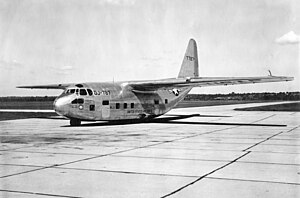Chase XG-20
| XCG-20/XG-20 | |
|---|---|
 |
|
| The second XG-20 prototype | |
| Role | Assault glider |
| Manufacturer | Chase Aircraft |
| Designer | Michael Stroukoff |
| First flight | April 1950 |
| Primary user | United States Air Force |
| Number built | 2 |
| Developed into |
C-123 Provider Chase XC-123A |
The Chase XCG-20, also known as the XG-20 and by the company designation MS-8 Avitruc, was a large assault glider developed immediately after World War II by the Chase Aircraft Company for the United States Air Force, and was the largest glider ever built in the United States. The XG-20 did not see production due to a change in USAF requirements, however, it was modified into the successful Fairchild C-123 Provider twin-engined transport aircraft which saw extensive service in the Vietnam War.
Following the end of World War II, the United States Army Air Forces, which became the United States Air Force (USAF) in 1947, developed a requirement for a new, large assault glider type to replace smaller types that were then in service, all existing gliders having been declared obsolete. The new gliders were to be constructed entirely of metal, and were also required to be easily adaptable to a powered configuration. As part of a five-year development program, a contract was awarded to the Chase Aircraft Company of Trenton, New Jersey, in August 1946 for the construction of two types of gliders. These included a smaller model being designated XCG-18A, and the larger, definitive model being designated XCG-20.
The XCG-20, redesignated XG-20 in 1948 with the establishment of the USAF, was the largest glider ever constructed in the United States, and the last combat glider to be built for the U.S. military. It featured a high-mounted wing and retractable tricycle landing gear, with an auxiliary power unit supplied hydraulic power to the landing gear and flaps. The nose section was reinforced to provide optimal protection to the pilots in the event of a crash on landing, and to allow for the strongest possible towing connection. The cargo hold was 30 feet (9.1 m) long and 12 feet (3.7 m) wide; it featured an innovative configuration, the rear fuselage being upswept with an integrated loading ramp. This allowed vehicles to be driven directly on and off of the aircraft, speeding loading and unloading times.
Although the first prototype XG-20 never flew as a glider, the second prototype conducted the aircraft's first flight in April 1950. Following being displayed to the public at Pope Air Force Base as part of Exercise Swarmer during that month, the XG-20 underwent thorough flight testing; during the late summer, it was evaluated against a variety of other transport aircraft at Eglin Air Force Base in Florida. Although it possessed no obvious faults, the test program confirmed that the powered "assault transport" was the equal of the glider in landing performance; having been rendered obsolete, the assault glider fell out of favor with the Air Force, and the XG-20 project was cancelled.
...
Wikipedia
